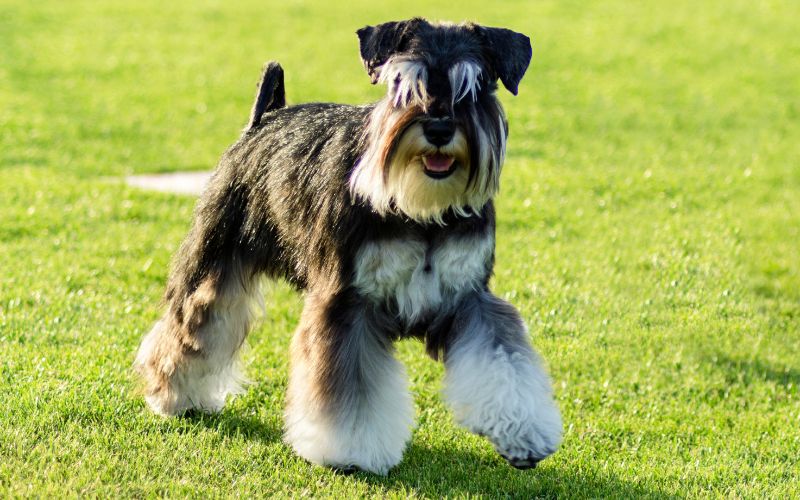As dog lovers, we are often fascinated by the breeding dynamics of our furry companions. And when it comes to Miniature Schnauzers, one of the most commonly asked questions is about their litter size. These small, lovable dogs have captured the hearts of many, and as prospective owners consider welcoming them into their homes, understanding their reproductive capabilities becomes essential. In this comprehensive article, we will delve into the factors that influence litter size in Miniature Schnauzers, exploring the science, genetics, and practical considerations behind this aspect of their breeding dynamics.
1. Introduction: Demystifying the Breeding Dynamics of Miniature Schnauzers

Before we dive into the specifics of litter size in Miniature Schnauzers, let’s take a moment to appreciate these delightful dogs. With their distinctive salt-and-pepper coats, cheerful dispositions, and unwavering loyalty, it’s no wonder that they are a popular breed among dog enthusiasts worldwide. But beyond their charming personalities, there is much to learn about their breeding dynamics.
Miniature Schnauzers belong to the Terrier group and were originally bred in Germany for their ratting abilities. Over time, they have become beloved family pets, known for their intelligence, playfulness, and affectionate nature. As with any breed, understanding their reproductive capabilities is crucial for responsible ownership. So, let’s explore the factors that influence litter size in Miniature Schnauzers.
2. Determining Litter Size: A Balancing Act of Nature and Nurture

The number of puppies born in a Miniature Schnauzer litter is not solely determined by genetics. It is a delicate balance between nature and nurture, with various factors coming into play. While certain genetic traits may affect the inherent fertility of individual dogs, external elements such as nutrition, breeding practices, and veterinary care also play a significant role in litter size.
Nature: Genetic Predispositions
Genetics plays a crucial role in shaping the reproductive capabilities of Miniature Schnauzers. Like all living beings, they inherit certain traits from their parents, including fertility. While there is no specific gene that determines litter size, certain factors can influence it.
One such factor is the size of the dog. Smaller dogs tend to have smaller litters, while larger dogs can have larger litters. This is because the size of the uterus and the number of eggs produced can vary based on the size of the dog. As Miniature Schnauzers are small dogs, they typically have smaller litters compared to larger breeds.
Another genetic factor that can affect litter size is the age of the breeding pair. As female dogs age, their fertility decreases, which can result in smaller litters. On the other hand, male dogs can continue to produce viable sperm well into their senior years, so their age may not have as significant an impact on litter size.
Nurture: Environmental Factors
While genetics may lay the foundation for litter size, environmental factors can significantly influence the actual outcome. One of the most crucial elements is nutrition. A well-balanced diet with the right amount of nutrients is essential for the overall health and fertility of breeding dogs. Inadequate nutrition can lead to poor reproductive health, resulting in smaller litters or even infertility.
Breeding practices also play a vital role in determining litter size. Responsible breeders carefully select healthy, genetically diverse breeding pairs to increase the chances of producing healthy puppies. They also ensure that the female dog is not overbred, as this can lead to complications and smaller litters.
Regular veterinary care is another crucial aspect of ensuring optimal litter size. Breeding dogs should undergo regular check-ups to monitor their reproductive health and address any potential issues promptly. This includes screening for conditions such as brucellosis, which can affect fertility in both male and female dogs.
3. Genetic Determinants: Unraveling the Mysteries of Heredity

As mentioned earlier, there is no specific gene that determines litter size in Miniature Schnauzers. However, certain genetic traits can influence their reproductive capabilities. Let’s explore some of these factors in more detail.
Inherited Fertility
Just like humans, dogs can also inherit fertility issues from their parents. These can include conditions such as uterine abnormalities, hormonal imbalances, or sperm quality issues. If a breeding pair has inherited fertility problems, it can significantly impact the number of puppies they produce.
Breeding Pair Compatibility
The compatibility between the breeding pair can also play a role in determining litter size. Dogs have a natural instinct to mate with genetically diverse partners, which helps to ensure the health and vitality of their offspring. When two dogs are too closely related, it can lead to smaller litters or even infertility.
Hormonal Imbalances
Hormonal imbalances can also affect the reproductive capabilities of Miniature Schnauzers. Female dogs require a delicate balance of hormones for successful breeding, including estrogen, progesterone, and oxytocin. Any disruption in this balance can result in smaller litters or difficulty conceiving.
Age and Health of the Breeding Pair
As mentioned earlier, the age and overall health of the breeding pair can also impact litter size. As female dogs age, their fertility decreases, and they may produce smaller litters. Similarly, if either dog has underlying health issues, it can affect their reproductive capabilities and result in smaller litters.
4. Practical Considerations: Preparing for a Litter of Miniature Schnauzer Puppies

Now that we have explored the various factors that influence litter size in Miniature Schnauzers let’s look at some practical considerations for preparing for a litter of puppies.
Preparing the Female Dog
Before breeding, it is essential to ensure that the female dog is in optimal health. This includes regular veterinary check-ups and screenings for any potential fertility issues. It is also crucial to provide her with proper nutrition and exercise to maintain her overall well-being.
During pregnancy, the female dog will require extra care and attention. She should be fed a high-quality diet designed for pregnant or nursing dogs, and her exercise should be limited to gentle walks. Regular check-ups with the veterinarian are also necessary to monitor her health and the development of the puppies.
Preparing the Male Dog
While the male dog’s role in breeding may seem less involved, he also requires proper care and preparation. Like the female, he should undergo regular check-ups to ensure his reproductive health. It is also essential to keep him physically fit and mentally stimulated to maintain his overall well-being.
Preparing for the Puppies
As the due date approaches, it is crucial to prepare for the arrival of the puppies. This includes setting up a whelping box, which is a safe and comfortable space for the mother to give birth and nurse her puppies. The box should be lined with soft bedding and kept in a quiet, warm area of the house.
It is also essential to have a plan in place for the puppies’ care and socialization once they are born. This includes finding suitable homes for them and providing them with proper veterinary care and early socialization experiences.
5. Litter Size in Miniature Schnauzers: A Look at the Numbers

Now that we have explored the various factors that influence litter size let’s take a look at some statistics. According to a study published in the Journal of Small Animal Practice, the average litter size for Miniature Schnauzers is 3.8 puppies. However, this number can vary significantly based on the factors we have discussed earlier.
The study also found that the average number of puppies per litter decreased as the female dog’s age increased. For example, dogs under two years old had an average litter size of 4.2 puppies, while those over six years old had an average litter size of 3.1 puppies.
6. Breeding Responsibly: The Importance of Ethical Practices

As with any aspect of pet ownership, it is crucial to approach breeding responsibly. This includes understanding the factors that influence litter size and ensuring that both the breeding pair and their offspring are well-cared for. It also means being mindful of the impact of overbreeding on the health and well-being of the dogs involved.
Responsible breeders carefully select healthy, genetically diverse breeding pairs and provide them with proper care and nutrition. They also limit the number of litters a female dog has in her lifetime to ensure her overall health and well-being. As prospective owners, it is essential to do thorough research and choose a reputable breeder who follows ethical practices.
Conclusion

In conclusion, the number of puppies born in a Miniature Schnauzer litter is influenced by a complex interplay of genetic predispositions, environmental factors, and the overall health and well-being of the breeding pair. While certain genetic traits may play a role in determining litter size, external elements such as nutrition, breeding practices, and veterinary care also exert a significant impact. By understanding these factors and approaching breeding responsibly, we can ensure the health and vitality of our beloved Miniature Schnauzers and their offspring.
